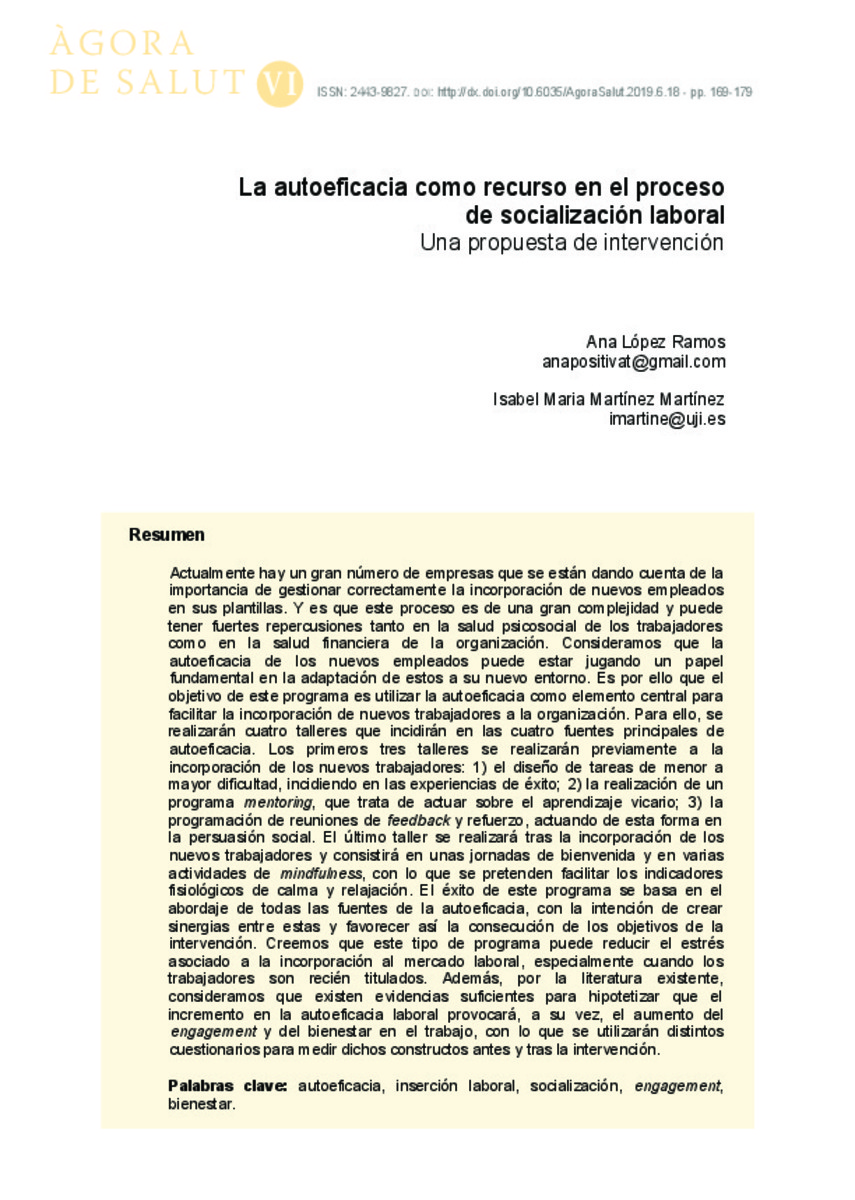Mostrar el registro sencillo del ítem
La autoeficacia como recurso en el proceso de socialización laboral. Una propuesta de intervención
| dc.contributor.author | López Ramos, Ana | |
| dc.contributor.author | Martinez, Isabel M. | |
| dc.date.accessioned | 2019-12-23T07:47:33Z | |
| dc.date.available | 2019-12-23T07:47:33Z | |
| dc.date.issued | 2019 | |
| dc.identifier.issn | 2443-9827 | |
| dc.identifier.uri | http://hdl.handle.net/10234/185590 | |
| dc.description.abstract | Actualmente hay un gran número de empresas que se están dando cuenta de la importancia de gestionar correctamente la incorporación de nuevos empleados en sus plantillas. Y es que este proceso es de una gran complejidad y puede tener fuertes repercusiones tanto en la salud psicosocial de los trabajadores como en la salud financiera de la organización. Consideramos que la autoeficacia de los nuevos empleados puede estar jugando un papel fundamental en la adaptación de estos a su nuevo entorno. Es por ello que el objetivo de este programa es utilizar la autoeficacia como elemento central para facilitar la incorporación de nuevos trabajadores a la organización. Para ello, se realizarán cuatro talleres que incidirán en las cuatro fuentes principales de autoeficacia. Los primeros tres talleres se realizarán previamente a la incorporación de los nuevos trabajadores: 1) el diseño de tareas de menor a mayor dificultad, incidiendo en las experiencias de éxito; 2) la realización de un programa mentoring, que trata de actuar sobre el aprendizaje vicario; 3) la programación de reuniones de feedback y refuerzo, actuando de esta forma en la persuasión social. El último taller se realizará tras la incorporación de los nuevos trabajadores y consistirá en unas jornadas de bienvenida y en varias actividades de mindfulness, con lo que se pretenden facilitar los indicadores fisiológicos de calma y relajación. El éxito de este programa se basa en el abordaje de todas las fuentes de la autoeficacia, con la intención de crear sinergias entre estas y favorecer así la consecución de los objetivos de la intervención. Creemos que este tipo de programa puede reducir el estrés asociado a la incorporación al mercado laboral, especialmente cuando los trabajadores son recién titulados. Además, por la literatura existente, consideramos que existen evidencias suficientes para hipotetizar que el incremento en la autoeficacia laboral provocará, a su vez, el aumento del engagement y del bienestar en el trabajo, con lo que se utilizarán distintos cuestionarios para medir dichos constructos antes y tras la intervención. ! | ca_CA |
| dc.description.abstract | A large number of companies are now realising the importance of properly managing the incorporation of new employees into their workforce. This process is highly complex and can have a strong impact on the psychosocial health of workers and the financial health of the organisation. We believe that the selfefficacy of new employees may be playing a key role in their adaptation to their new environment. That is why the aim of this programme is to use self-efficacy as a central element to facilitate the incorporation of new workers into the organisation. To this purpose, four workshops will be held that will focus on the four main sources of self-efficacy. The first three workshops will be held prior to the incorporation of new workers: 1) the design of tasks from least to most difficult, focusing on successful experiences; 2) the implementation of a mentoring program, which seeks to act on vicarious learning; 3) the scheduling of feedback and reinforcement meetings, thus acting in social persuasion. The last workshop will take place after the incorporation of the new workers and will consist of welcome days and various mindfulness activities, which are intended to facilitate physiological indicators of calm and relaxation. The success of this programme is based on addressing all sources of self-efficacy, with the intention of creating synergies between them, and thus promoting the achievement of the objectives of the intervention. We believe that this type of program can reduce the stress associated with entering the labor market, especially when workers are newly qualified. In addition, from the existing literature, we consider that there is sufficient evidence to hypothesize that the increase in labor self-efficacy, in turn, will provoke an increase in engagement and well-being at work, with which different questionnaires will be used to measure these constructs before and after the intervention. | ca_CA |
| dc.format.extent | 11 p. | ca_CA |
| dc.format.mimetype | application/pdf | ca_CA |
| dc.language.iso | spa | ca_CA |
| dc.publisher | Publicacions de la Universitat Jaume I. Servei de Comunicació i Publicacions | ca_CA |
| dc.relation.isPartOf | Àgora de salut, 2019, vol. 6 | ca_CA |
| dc.rights | © Del text: els autors i les autores, 2019 © D’aquesta edició: Publicacions de la Universitat Jaume I, 2019 | ca_CA |
| dc.rights | Atribución-CompartirIgual 4.0 Internacional | * |
| dc.rights.uri | http://creativecommons.org/licenses/by-sa/4.0/ | * |
| dc.subject | autoeficacia | ca_CA |
| dc.subject | inserción laboral | ca_CA |
| dc.subject | socialización | ca_CA |
| dc.subject | engagement | ca_CA |
| dc.subject | bienestar | ca_CA |
| dc.subject | self-efficacy | ca_CA |
| dc.subject | job placement | ca_CA |
| dc.subject | socialization | ca_CA |
| dc.subject | engagement | ca_CA |
| dc.subject | well-being | ca_CA |
| dc.title | La autoeficacia como recurso en el proceso de socialización laboral. Una propuesta de intervención | ca_CA |
| dc.type | info:eu-repo/semantics/article | ca_CA |
| dc.identifier.doi | http://dx.doi.org/10.6035/AgoraSalut.2019.6.18 | |
| dc.rights.accessRights | info:eu-repo/semantics/openAccess | ca_CA |








